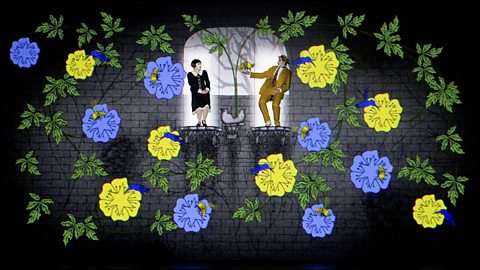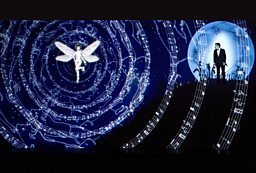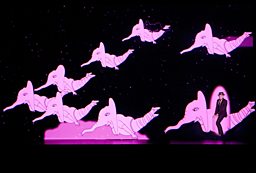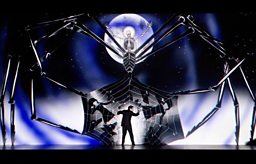Kaleidoscopera: Animating Mozart's The Magic Flute
30 August 2015
Komische Oper Berlin's production of The Magic Flute has become one of the hits of the Edinburgh International Festival. Directed by Australian Barrie Kosky, fresh from Glyndebourne and a celebrated production of Handel's Saul, his radical take on Mozart's opera has enjoyed a similar critical reaction. Key to this has been his collaboration with Hackney Wick-based animators 1927 (so named as this was year that the talkies were popularised).
Paul Barritt and Suzanne Andrade from the company are integral to what is a stunning re-imagining of the opera as a live-action cartoon. In the film below, the couple discuss their work, along with excerpts from the production, while PAUL BARRITT writes 'in character' to explain further 1927's artistic process.

The Magic Flute rebooted by Komische Oper Berlin, Barrie Kosky and British theatre group 1927
1927's Artistic Directors discuss its exhilarating mix of live action & animation.
The Making of the Magic Flute
In the style of one of its characters, 1927's co-founder and animator Paul Barritt describes how The Magic Flute production was conceived...
The question: “how is it done?” is the phenomenon I intend to disclose to you here today, dear reader. What is the science behind this weird alchemy? The ingredients to this piquant broth? The mechanics of this well oiled . . . I’m getting distracted . . . a fly has just entered this fusty laboratory and landed in my ale.
As I watch said insect flailing drunkenly in the intoxicating mire I am reminded of myself somewhat when starting out upon a project such as the one we are here discussing. Yes, intoxicated, drunk on the heady ideas conjured up by my fellow magi and I (Mme Andrade and Herr Kosky) yet floundering dizzily in the murky and unclear depths of alcoholic despair, wondering how upon this godforsaken planet to actually bring into being such a novel apparition as this.
My first port of call is Andrade’s house (a rickety hovel found in the depths of the East End, infested with cats). Here I find her already at work with quill and ink. She has been listening to the music of Herr Mozart upon an old phonograph over and over again and writing out lists of the events that need to happen for the individual scenes whilst at the same time working out the choreography needed.
We discuss in detail said events, often shifting and changing the ideas to fit with the logistics of the stage. We fall out, we make it back up again, I leave, parchment under arm and head back to the lab.
Once at the lab I undertake the time-consuming and painstaking task of drawing out the necessary animated scenes. For this I use my trusty pencils and pens and a glass box lit from beneath (I use a local family of glow-worms for this but others might use different means).
Once this is done I then take the drawings over to my “Cabinet of Mystery”. Handed down to me by the Mighty Creator himself via the speedy delivery of Hermes Tristmagistmus, the symbol of the Fall of Man emblazoned upon its side (that dread bite taken from the side of the fated apple).
I then proceed to scan the pictures into the magic box, they appear one then two, three, four, five, six and so on until all are contained within. I quaff deeply of my ale, crack my knuckles and begin to manipulate the said images into the animated events that will be played out upon the stage.


Once completed I sublimate the brew via a mysterious process known as “Rendering” and they emerge as finished articles, the well known wizard of Quick Time having sprinkled his magic dust upon them.

From the chaos, order has emerged and a list of cues is lain out before me. This is then transferred into the burning hot alembic, the server of wishes, the painfully clawed fist of the one known as the Cat. The Cat is short for Catalyst (a device not dissimilar to the Cabinet of Mystery but used solely for the playing back of the now finished animated apparitions).
Once the ingredients are added to the Catalyst the explosions begin. I speedily attach the Catalyst equipment to the extremely powerful magic lantern set up at the back of the theatre, switch it all on and, low and behold, the flickering images of dragons and elephants and weird birds emerge upon the stage.
It works! We are all amazed at the result. I then hand over the whole thing to the witchery of Andrade whose job it is to manipulate the performers in such a way as to bring the apparitions to life upon the stage. This itself is a craft both intricate and mysterious and is another complete chapter in the process.
This short description, however, I hope will satisfy the curiosity of those amateurs amongst you as to the basic technical procedures used to create such a production as this. Whilst I doubt we have discovered the philosopher’s stone just yet we did find a few chinks of light along the way.
Master Paul Bill Barritt (Clapton Pond, 1927)
The Magic Flute is at the Festival Theatre, Edinburgh, 27 - 30 August 2015.

Related Links
The Magic Flute – Creative Team (www.eif.co.uk)
Komische Oper Berlin
Co-directed by Barrie Kosky and Suzanne Andrade
Kristiina Poska Musical direction
Suzanne Andrade and Barrie Kosky Staging
Paul Barritt Animations
Concept by 1927 (Suzanne Andrade and Paul Barritt) and Barrie Kosky
-
![]()
Israel Galvan
The acclaimed flamenco dancer talks about his most recent work, Lo Real (The Real) which tells the story of the Nazi persecution of Roma and Sinti people during the Holocaust.
-
![]()
In Conversation
In partnership with Edinburgh International Festival, BBC Arts presents four of the world's leading lights in theatre and dance interviewed in front of an audience and streamed live online.
-
![]()
The Harmonium Project
The spectacular opening event of the Edinburgh International Festival - a unique collaboration to celebrate the 50th anniversary of the Edinburgh Festival Chorus.



